Dr. Barak Bouks (Ph.D.)
The Europa Institute, Department of Political Studies,
School of Communication,
Bar-Ilan University, Israel
DOI: https://doi.org/10.37458/ssj.4.1.8
Review Paper
Received: February 14, 2023
Accepted: March, 19, 2023
Abstract: Israel is characterized as a Jewish democratic state. Its location in the Middle-East is a driver of significant unique security threats and challenges for its citizens. Albeit having peace treaties with Egypt, Jordan and the PA (Palestinian Authority), culminating with the Abraham accords in the regional arena, it is still surrounded by hostile countries such as Syria and Lebanon vis-à-vis terror groups, culminating with Iran in the broader arena, which can be defined as a patron of terror to all of the above. Through a discussion of the following main hypotheses, this article will discuss key strategic, media influential and in some cases technological threats to Israel from the noted states and terror groups:
A. Israel must meet security challenges as attacks from enemy states and terror groups. Some of these groups perpetrate from the territories of states that have a peace treaty with Israel.
B. These attacks are characterized as conventional terror (culminating with suicide attacks), Influential (Anti-Israeli propaganda via Media or New Media) & Cyber technological.
This article finds that Israel has to combat various security challenges:
a) Strategically, by fortifying its borders & counter terror groups insurgency
b) Meeting the influential arena by developing new media tools and sophisticated means of relaying its message
c) Providing technological solutions to Cyber threats: Sophisticated counter attacks and defense shields in order to meet attacks from enemy states and terror groups.
Keywords: Terror Groups, Security, Media, Influence, Cyber/Technology.

1. Introduction:
Israel is characterized as a Jewish democratic state. Its location in the Middle-East is a driver of significant unique security threats and challenges for its citizens. Albeit having peace treaties with Egypt, Jordan and the PA (Palestinian Authority), culminating with the Abraham accords in the regional arena, it is still surrounded by hostile countries as Syria and Lebanon vis-à-vis terror groups, culminating with Iran in the broader arena, which can be defined as a patron of terror to all of the above. Israel’s main challenges will be referred to as Strategic terror insurgency, influence & technology.
We can define two main hypotheses:
A. Israel has to meet security challenges as attacks from enemy states and terror groups. Some of these groups perpetrate from the territories of states that have a peace treaty with Israel.
B. These attacks are characterized as conventional terror (culminating with suicide attacks), Influential (Anti-Israeli propaganda via Media or New Media) and Cyber technological.
2. Mapping the Challenging Threats of Israel:
We can map key threats aimed at Israel by hostile states and terror groups, surrounding the country as is detailed in Figure 1. The threats originate from enemy states including Lebanon, Syria or Iran. Threats originate from terror groups operating from states with which Israel has a peace treaty including Egypt (ISIS operating from the Sinai Peninsula), Jordan and the Palestinian authority (with which Israel implements the Oslo accords and cooperates with its political and security grid). , Palestinian terror groups also operate from the territories controlled by the Palestinian authority. Hamas is a distinct case as it is a terror group which controls the Gaza strip, hence, we meet a unique modus operandum of a terror-controlled governance. Iran is defined as the key coordinator of Muslim terror groups in the Middle-East and the global arena, operating against Israel and Jewish targets both regionally and globally.
Figure 1: States and Terror Groups that Threaten Israel
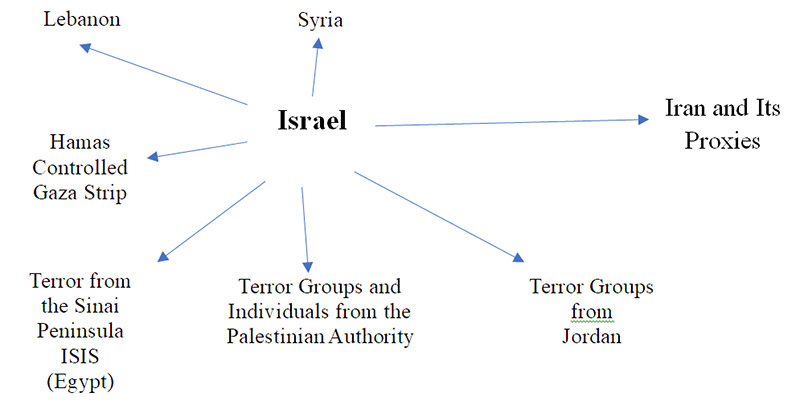
Figure 2, presents a systematic method detailing the typology of the these threats according to which level Israel is met by the terror perpetrator (individual, group), what type of attack may be implemented against Israel (rockets or drones- long, medium or short ranged), and in addition, the following dimensions: Technological (as computer cyber-attacks), Influential (via new media) and Psychological (Propaganda designated at influencing global states, regional Arab audiences, and local Israeli citizens).
Figure 2: Security Threats on Israel
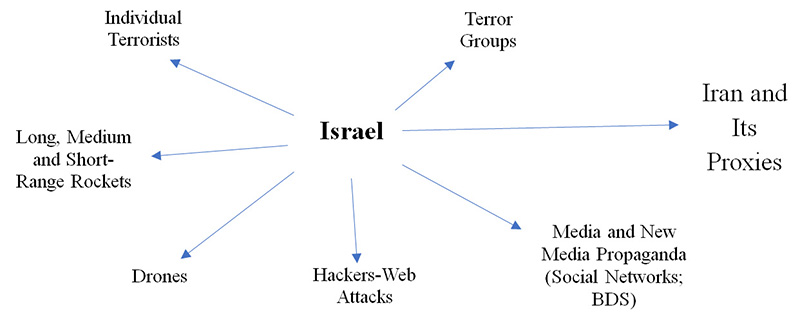
2.1 States that have a Peace Treaty with Israel:
We can relate to three parallel dimensions of threats:
1. Security/Terror
2. Influence
3. Cyber and Technology.
Egypt and Jordan are two states with which Israel signed a peace treaty:
Egypt, governed by President Abdel Fattah El-Sisi, presents the following terrorist security threats:
1. Sinai- ISIS Sinai province (also Al-Qa’ida)- Local tribesmen: Terror attacks, smuggling, trafficking.
2. Muslim Brotherhood collaborating with Palestinian terror groups as Hamas. Note- President El-Sisi’s government operates against these movement while occasionally coordinating with Israel as its ally.
If we relate to the realm of influence, we can note that:
1. There is a use by terror groups of new media as clips and proclamations- according to the techniques of ISIS.
2. These groups operate an expatriate opposition media (as the Muslim Brotherhood in Istanbul, Turkey).
3. We cannot relate to a specific cyber threat .
Similarly, Jordan, which is ruled by Hashemite King Abdullah II.
We can relate solely to terror security threats as:
1. Palestinian terror groups (Hamas, Palestinian Islamic Jihad, etc.’.).
2. Terror groups from Syria (as they infiltrated refugee camps in Northern Jordan).
2.2 The Palestinian Authority (Also Hamas Controlled Gaza):
The Palestinian Authority is headed by President Mahmoud Abbas and Prime Minister Mohammad Shtayyeh. It was established following the Oslo accords with Israel signed in 1993, yet, the Gaza Strip has been controlled by Hamas since 2007, which is a terror group, headed Yahya Sinwar- who is a de facto ruler and Ismail Haniyeh- who is the head of the Political Bureau (Abroad) .
The noted three parallel dimensions of threats:
1. Terror/Security: Terror groups operate from the PA culminating with Hamas, as its security forces operate within a limited manner. Note that we can relate to Hamas in Gaza as a terror state.
2. Influence: Both the PA and Hamas maintain an Anti-Israeli State Run Media (and New Media). Other terror groups as the Palestinian Islamic Jihad (PIJ), operate their own independent media (and New Media). The following chapter will elaborate this item.
3. Cyber and Technology: We can relate mostly to Hamas as its operations include:
1. Cyber-attacks (e.g., Bot profiles, Facebook “Honey Traps”) .
2. Long medium and short-range rockets.
3. Drones
4. Cameras & Surveillance of the Israeli Army and Civilians.
2.3 Examples of Influence: The Palestinian Authority, Hamas & Palestinian Islamic Jihad (PIJ):
2.3.1 P.A’s Formal TV:
Following a terror attack on November 16, 2022, in which three Israelis were killed in the city of Ariel, formal PA TV did not relate to the atrocities but focused on terrorist prisoners in Israel.
Picture 1:

More tweets related to propaganda of youth being detained in Nablus or shot through demonstrations.
Picture 2:

We can relate also to tweets of an allegedly Jewish settlers attacking Palestinians south of Jericho.
Picture 3:

(Pictures 1-3, are retrieved from the P.A’s Formal TV tweeter page, November 16, 2022).
The Palestinian Authority brands itself via national media as a functioning government via a live report from October 25th, 2022, of an anti-terror activity by the Israeli military against “Lions’ Den” insurgent terror group, while noting a special meeting of the Palestinian President Mahmoud Abbas (Abu-Mazen).
Picture 4:
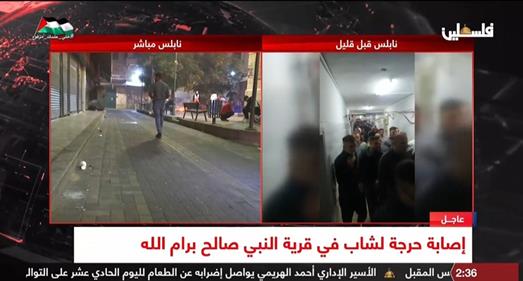
(P.A’s Formal TV, October 25, 2022).
2.3.2 Hamas’ Media:
Hamas operates an equivalent media array to the PA, as it considers itself a government. Hamas presented in its official TV page “Al-Aqsa” on August 7, 2022, following a rocket launch on the South and Central Israel culminating in Tel-Aviv, a clip of celebrations in Jaffa (Tel-Aviv), noting "The joy of Jaffa Palestinians as the rockets launched by the resistance arrived from Gaza". They refer to Arab citizens of Tel-Aviv Israel!
Picture 5:
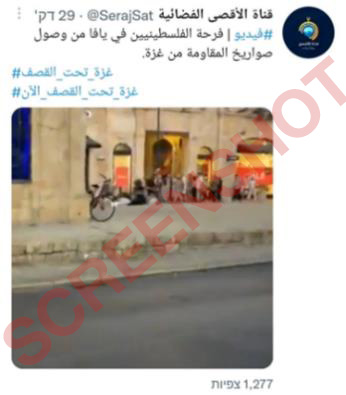
(Hamas’ official TV page “Al-Aqsa”, August 7, 2022).
On March 27, 2022, following a Terror Attack in Hadera (Hasharon Israel): Hamas' "Al-Aqsa" Channel coverage was an initial report of the terror attack titled: "(Two) settlers were killed and four more wounded", graphically bolding this topic while an ambulance serves as a background picture. The channel continued by updating the viewers/readers of its new media, with raw footage which was retrieved from the terror site. The terrorists were defined as killing settlers as again it is inside the green line (in a proximity to the center)!
See Picture 6:
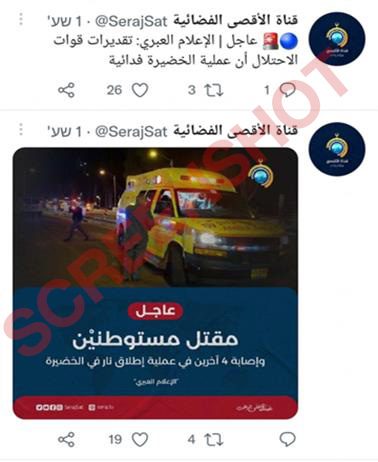
(Hamas’ official TV page “Al-Aqsa”, March 27, 2022).
2.3.3 Palestinian Islamic Jihad PIJ TV:
Enclosed are some DX’ing of the Palestinian Islamic Jihad PIJ’s New Media tweeter page, following an integrated terror attack in Jerusalem, November 23, 2022, “Explosion scenes from “Occupied” Jerusalem killed 1 settler and injured 19 Others”. Note- The attack occurred in West Jerusalem which is inside the green line, hence, the PIJ refers to all of the Israelis as “Settlers”.
Picture 7:

(Palestinian Islamic Jihad (PIJ) TV Tweeter Page, November 23, 2022).
2.4 Enemy States:
The noted three parallel dimensions of threats: 1. Security/Terror; 2. Influence; 3. Cyber and Technology, are more significant as they evolve from enemy states surrounding Israel: Syria and Lebanon. We can characterize Syria as an enemy state, ruled by President Bashar Al-Assad. Syria singed the disengagement agreement with Israel in 1974, following the Yom-Kippur war in 1973. Item 1, Security/Terror may be defined according to the following governmental/terror groups operating from Syria: 1. The Syrian army (culminating with responses to alleged aerial attacks, by the air defense forces.
2. Iranian forces.
3. Lebanese Hezbollah.
4. Palestinian terror groups.
5. Other Iranian proxies.
Note: There is a division between a pro-western establishment versus a pro-Iranian Hezbollah which controls the state.
Item 2, influence, is manifested according to the publications of the Syrian news agency SANA & Syrian governmental TV. Cyber-attacks are allegedly perpetrated by the “Syrian Electronic Army”, and thus one can notice Item 3, Cyber and Technology.
Same also, Lebanon, that can be defined as an enemy state, which is divided between Muslims 67.8% (31.9% Sunni, 31.2% Shia), Christians 32.4%, Druze 4.5%, and other minorities . Lebanon was governed until October 2022 by President Michel Aoun, while Prime-Minister Najib Mikati serves as a head of a transitional government.
Lebanon signed the maritime border agreement with Israel in October, 2022, yet, it is not considered as a peace treaty but a technical arrangement, mediated by a 3rd party (USA.). The Lebanese army maintains regular meetings with Israeli representatives under the patronage of UNDOF every three weeks. Item 1, Security/Terror can be cataloged according to the operation of the following groups:
1. Hezbollah- Secretary General Hassan Nasrallah.
2. Hamas’ forces from Lebanese refugee camps.
3. Palestinians from refugee camps.
Hezbollah, is the most significant group that meets item 2, influence, via Hezbollah’s media (TV, Radio & New Media), as well as affiliated informal channels (Al-Mayadeen). Item 3, is more relevant to Iranian cyber attacks (See item 2.5 Iran and Regional Proxies) .
2.5 Iran and Regional Proxies:
Iran will be referred to as an enemy state, in a separate chapter due to an extensive proxy operation as will be demonstrated significantly in media examples of chapter 2.5.1. The Supreme leader of Iran is a religious figure, Ali Khamenei. President Ebrahim Raisi is the political leader of the country which is defined as an enemy state to Israel from the 1979 revolution headed by Ayatollah Ruhollah Komeini, following a strong alliance with the imperial regime of Shah Mohammad Reza Pahlavi Pahlavi . Iran implements a security terror threat (item 1), to Israel as follows:
1. Revolutionary Guards operating in the regional arena.
2. Threats against Israelis in the global arena (assassinations, kidnapping, etc.’).
3. Supporting enemy states and proxies and terror groups, in the regional arena.
4. Destabilizing pro-western Arab states, or anti Iranian governments in the regional arena while threatening the personal safety of the citizens of Israel (and the neighbouring states).
Iran's direct influence (item 2), is via Iranian news agency IRIB, allegedly supporting proxies as Houthi revels, Hamas, etc.’. Yet, the coordination of proxies in chapter 2.5.1, may characterize its main activities.
Iran has implemented a thorough cyber-attacks on infrastructures (item 3), as breaking into cameras while documenting terror attacks in Jerusalem (Heller, 2022) or a cyber-attack against water infrastructures in Israel (May 7, 2020) .
2.5.1 Examples of Influence: Iran and Its Proxies:
2.5.1.1 Hezbollah:
Hezbollah’s official web-site of its TV, “Al-Manar”, related in October 1, 2022, in a news-flash to the signature of the maritime border agreement between Israel-Lebanon, by branding it as a victory: This report is one of a series of Hezbollah’s secretary general Hassan Nasrallah’s live speech’s transcription retrieved from TV: “Sayyed Nasrallah: Maritime victory is the fruit of the national solidarity and will help Lebanon cope with economic crisis”.
Picture 8 :

2.5.1.2 Syria (Under Iranian Influence):
Syria has a formal news agency SANA, a governmental TV & Radio, New-Media while it also maintains a Hebrew page designated to Israelis (as a daily radio programme). On November 19, 2022 (06:30 AM), it reported in Hebrew of an allegedly combined Israeli attack from the Mediterranean and the city of Banias (While in this specific case there were no other reports in SANA’s Arabic or English).
Picture 9 :
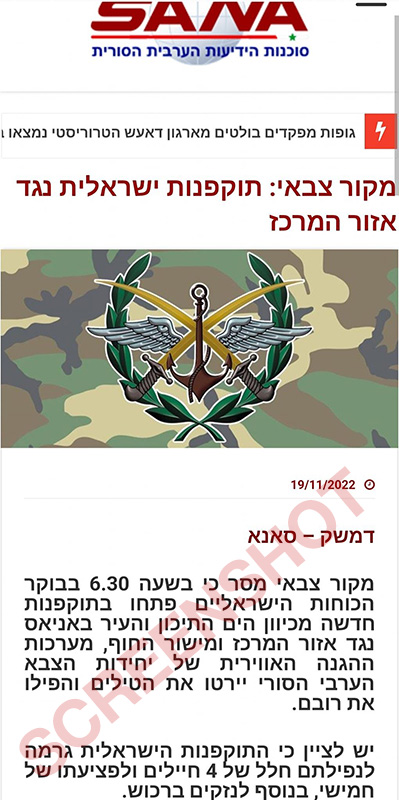
Note that the Syrian opposition has its own media (as TV and New-Media), on which one can compare the reports from November 19, 2022 (The opposition noted that President Assad’s officers were killed, while presenting raw footage of the allegedly attacks).
Pictures 10:
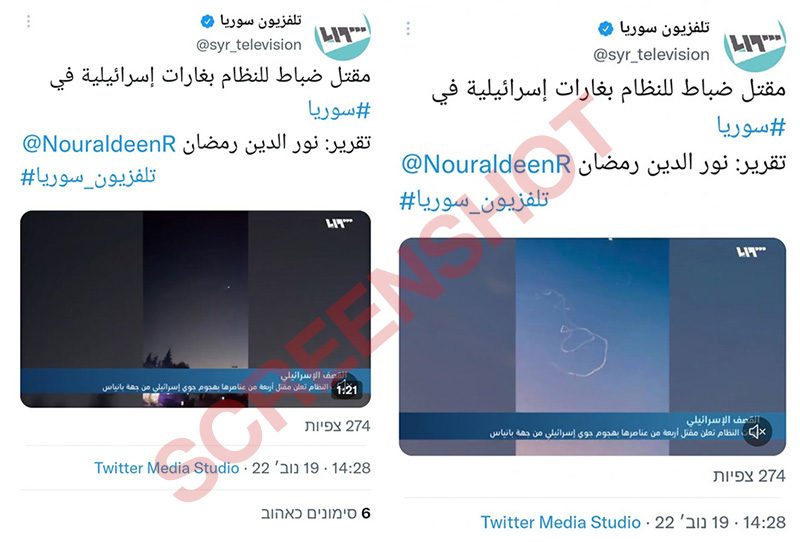
(Syrian opposition TV tweeter page, November 19, 2022).
2.5.1.3 Houthi Rebels:
Houthi controlled Yemen (a Shiite tribe backed by Iran), makes use of the governmental news agency SABA-NET for anti-Saudi/US. coalition reports, as from June 20, 2021 noting coalition planes killed Yemenite civilians while an espionage US Eagle air plane was toppled by a Houthi missile.
Picture 11 :
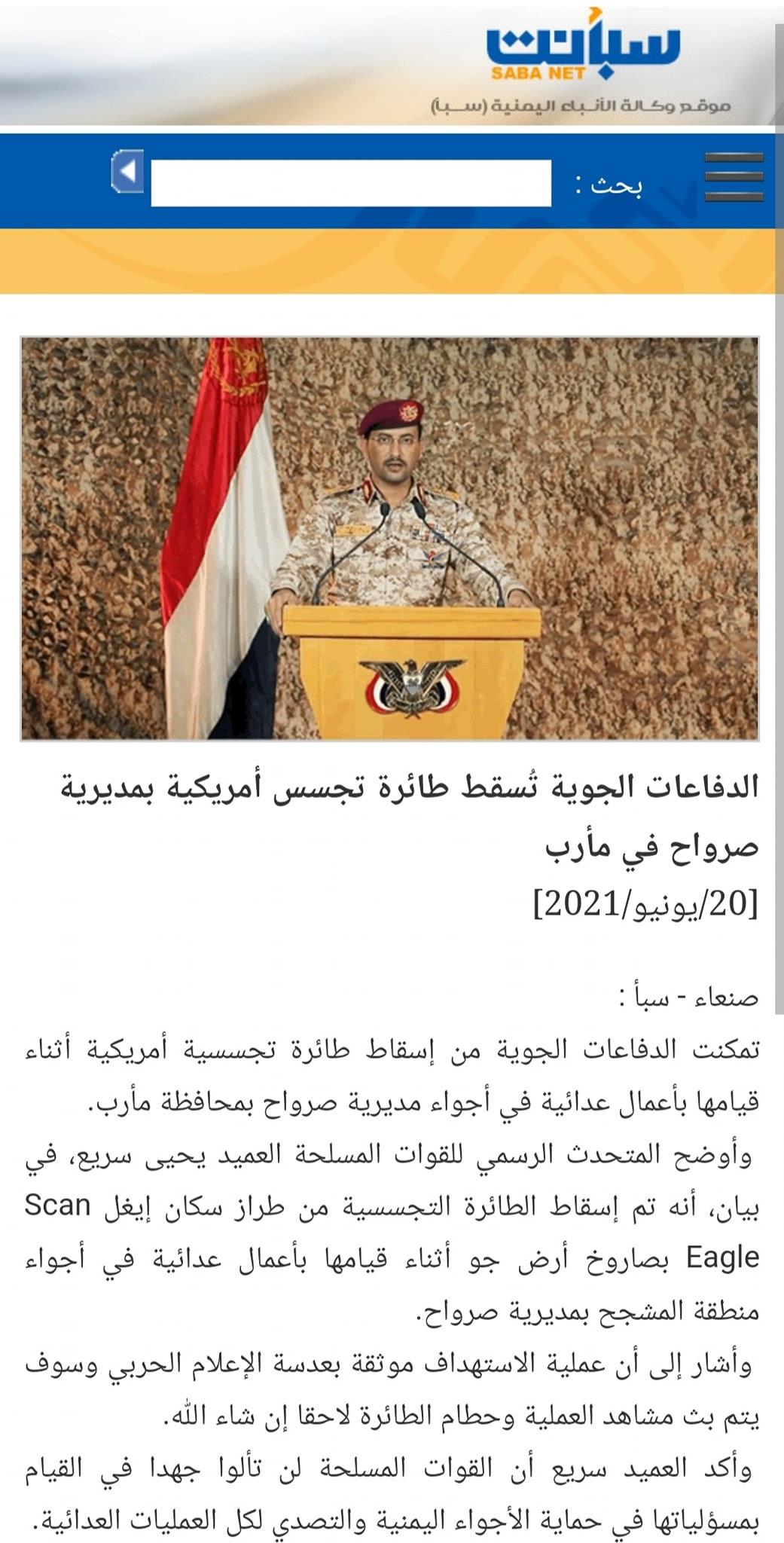
3. Conclusions:
Israel must combat various security challenges:
A. Strategically, by fortifying its borders and counter terror groups insurgency.
B. Meeting the influential arena by developing new media tools and sophisticated means of relaying its messages.
C. Providing technological solutions to cyber threats: Sophisticated counter attacks and defense shields to meet attacks from enemy states and terror groups.
References
- "A Report: Iran is Responsible for a Cyber Attack Last Month Against Water Infrastructures in Israel", Haaretz. Last Modified May 7, 2020. Retrieved February 9, 2023, from https://www.haaretz.co.il/news/politics/2020-05-07/ty-article/0000017f-e181-d7b2-a77f-e387b5e00000
- “Al-Manar”, website October 1, 2022, Retrieved February 9, 2023, from https://www.almanar.com.lb/.
- “CIA Factbook”, CIA. Retrieved February 9, 2023, from https://www.cia.gov/the-world-factbook/countries/.
- "Hamas: Palestinian Nationalist Movement", Britannica. Retrieved February 9, 2023, from https://www.britannica.com/topic/Hamas.
- Hamas’ official TV page “Al-Aqsa”, August 7, 2022.
- Hamas’ official TV page “Al-Aqsa”, March 27, 2022.
- Heller, Shlomi. "Iranian Hackers Broke into Cameras of a Large Security Institution and Published a Documentation of the Jerusalem Terror Attack", Walla. Last Modified November 24, 2022. Retrieved February 9, 2023, from
- https://news.walla.co.il/item/3542328
- P.A’s Formal TV, October 25, 2022.
- P.A’s Formal TV Tweeter Page, November 16, 2022.
- Palestinian Islamic Jihad (PIJ) TV Tweeter Page, November 23, 2022.
- "Sana", Website November 19, 2022, Retrieved February 9, 2023, from https://www.sana.sy/he/.
- "Saba Net", Website June 20, 2021, Retrieved February 9, 2023, from https://www.sabanew.net/home/en.
- Syrian opposition TV tweeter page, November 19, 2022.
- "The Oslo Accords", Britannica. Retrieved February 9, 2023, from https://www.britannica.com/place/Israel/The-Oslo-Accords.
- Zilber, Neri. "Inside the Cyber Honey Traps of Hamas". Daily Beast. Last Modified March 1, 2020. Retrieved February 9, 2023, from https://www.thedailybeast.com/inside-the-cyber-honey-traps-of-hamas .
Notes:
1 “CIA Factbook”, CIA. Retrieved February 9, 2023, from https://www.cia.gov/the-world-factbook/countries/ .
2 “CIA Factbook”, CIA. Retrieved February 9, 2023, from https://www.cia.gov/the-world-factbook/countries/ .
3 "The Oslo Accords", Britannica. Retrieved, February 9, 2023, from https://www.britannica.com/place/Israel/The-Oslo-Accords; "Hamas: Palestinian Nationalist Movement", Britannica. Retrieved, February 9, 2023, from https://www.britannica.com/topic/Hamas.
4 Neri Zilber. "Inside the Cyber Honey Traps of Hamas". Daily Beast. Last Modified March 1, 2020.
Retrieved, February 9, 2023, from https://www.thedailybeast.com/inside-the-cyber-honey-traps-of-hamas.
5 An estimation from 2020 according to CIA Factbook.
“CIA Factbook”, CIA. Retrieved February 9, 2023, from https://www.cia.gov/the-world-factbook/countries/.
6 “CIA Factbook”, CIA. Retrieved February 9, 2023, from https://www.cia.gov/the-world-factbook/countries/.
7 “CIA Factbook”, CIA. Retrieved February 9, 2023, from https://www.cia.gov/the-world-factbook/countries/.
8 "A Report: Iran is Responsible for a Cyber Attack Last Month Against Water Infrastructures in Israel", Haaretz. Last Modified May 7, 2020. Retrieved February 9, 2023, from
https://www.haaretz.co.il/news/politics/2020-05-07/ty-article/0000017f-e181-d7b2-a77f-e387b5e00000.
9 "Al-Manar", website October 1, 2022, Retrieved February 9, 2023, from https://www.almanar.com.lb/.
10 "Sana", Website November 19, 2022, Retrieved February 9, 2023, from https://www.sana.sy/he/.
11 "Saba Net", Website June 20, 2021, Retrieved February 9, 2023, from https://www.sabanew.net/home/en.